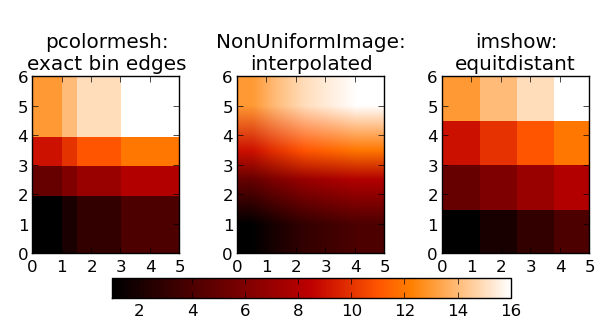Here is an example for creating a 2D histogram with variable bin size and displaying it.
1 #!/usr/bin/python
2 import numpy as np
3 import matplotlib as ml
4 import matplotlib.pyplot as plt
5
6
7 # First we define the bin edges
8 xedges = [0, 1, 1.5, 3, 5]
9 yedges = [0, 2, 3, 4, 6]
10
11 # Next we create a histogram H with random bin content
12 x = np.random.normal(3, 1, 100)
13 y = np.random.normal(1, 1, 100)
14 H, xedges, yedges = np.histogram2d(y, x, bins=(xedges, yedges))
15
16 # Or we fill the histogram H with a determined bin content
17 H = np.ones((4, 4)).cumsum().reshape(4, 4)
18 print H[::-1] # This shows the bin content in the order as plotted
19
20 ml.rcParams['image.cmap'] = 'gist_heat'
21
22
23 fig = plt.figure(figsize=(6, 3.2))
24
25 # pcolormesh is useful for displaying exact bin edges
26 ax = fig.add_subplot(131)
27 ax.set_title('pcolormesh:\nexact bin edges')
28 X, Y = np.meshgrid(xedges, yedges)
29 plt.pcolormesh(X, Y, H)
30 ax.set_aspect('equal')
31
32
33 # NonUniformImage can be used for interpolation
34 ax = fig.add_subplot(132)
35 ax.set_title('NonUniformImage:\ninterpolated')
36 im = ml.image.NonUniformImage(ax, interpolation='bilinear')
37 xcenters = xedges[:-1] + 0.5 * (xedges[1:] - xedges[:-1])
38 ycenters = yedges[:-1] + 0.5 * (yedges[1:] - yedges[:-1])
39 im.set_data(xcenters, ycenters, H)
40 ax.images.append(im)
41 ax.set_xlim(xedges[0], xedges[-1])
42 ax.set_ylim(yedges[0], yedges[-1])
43 ax.set_aspect('equal')
44
45 # Imshow is useful for a simple equidistant representation of bin content
46 ax = fig.add_subplot(133)
47 ax.set_title('imshow:\nequitdistant')
48 im = plt.imshow(H, interpolation='nearest', origin='low',
49 extent=[xedges[0], xedges[-1], yedges[0], yedges[-1]])
50
51
52 # Finally we add a color bar
53 cax = fig.add_axes([0.12, 0.1, 0.78, 0.4])
54 cax.get_xaxis().set_visible(False)
55 cax.get_yaxis().set_visible(False)
56 cax.patch.set_alpha(0)
57 cax.set_frame_on(False)
58 plt.colorbar(orientation='horizontal', ax=cax)
59 plt.tight_layout()
60 plt.show()
